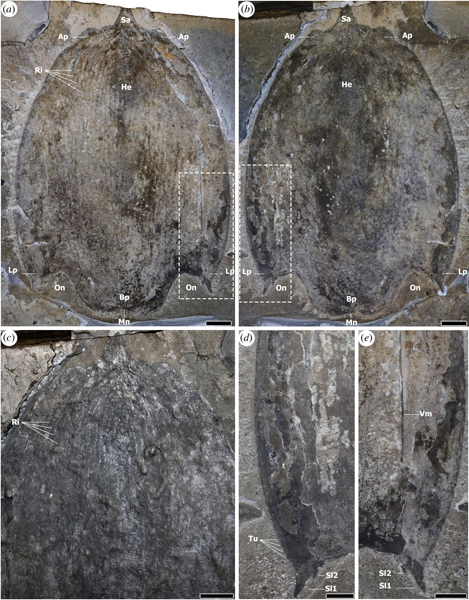Researchers from the Royal Ontario Museum (Canada), have announced the discovery of a new species of armoured arthropod from the Burgess Shale of British Columbia. A study looking at 12 fossil specimens collected from Marble Canyon and Tokumm Creek in the Kootenay National Park (British Columbia), has been published this week by Royal Society Open Science. The arthropod has been named Titanokorys gainesi and at around 50 cm in length, it is a giant by Cambrian biota standards.

The authors of the scientific paper, Dr Jean-Barnard Caron of the Royal Ontario Museum, an expert on Burgess Shale fauna and PhD student Joe Moysiuk, classify Titanokorys as a member of the Radiodonta, a stem group of the Arthropoda. Radiodonts were extremely diverse and geographically widespread during the Late Cambrian and many of them were giants when compared to other animals alive during this time in Earth’s history. Perhaps the most famous radiodont is the taxon Anomalocaris, regarded by many palaeontologists as the world’s first super-predator.
The picture (above) shows a model of an Anomalocaris. This figure is part of the CollectA Prehistoric Life model range.
To view this range: CollectA Prehistoric Life.
Living on the Seabed – A Benthic Existence
Radiodonts are characterised by their compound eyes, disc-shaped mouthparts and paired frontal appendages, which in the case of Titanokorys consist of comb-like structures which may have been used to sift through mud in search of prey. The broad, flattened carapace of Titanokorys supports the idea that it was benthic – living on the seabed.

Dr Caron stated:
“The sheer size of this animal is absolutely mind-boggling, this is one of the biggest animals from the Cambrian period ever found.”
Coeval with Cambroraster falcatus
The bedding planes that provided the Titanokorys fossil material have also revealed an abundance of the smaller, but closely related Cambroraster falcatus, which was named and described by Caron and Moysiuk in 2019. Cambroraster was named after the Millennium Falcon from Star Wars franchise, as its carapace resembled the shape of this iconic spaceship. The co-occurrence of these two species on the same bedding planes highlights potential competition for benthic resources and the high diversity of large predators sustained by Cambrian communities.
To read about the discovery of Cambroraster falcatus: Prehistoric Predator with a Mouth Shaped Like a Pineapple Ring.
Why some radiodonts evolved such a bewildering array of head carapace shapes and sizes is still poorly understood and was likely driven by a variety of factors.

Dr Caron added:
“These enigmatic animals certainly had a big impact on Cambrian seafloor ecosystems. Their limbs at the front looked like multiple stacked rakes and would have been very efficient at bringing anything they captured in their tiny spines towards the mouth. The huge dorsal carapace might have functioned like a plough.”
Honouring Professor Robert Gaines
The genus name is derived from the Greek Titans, powerful gods of huge size and from the Greek “Korys” for helmet. The species or trivial name honours Professor Robert Gaines who was instrumental in the co-discovery of the Marble Canyon fossil deposit, where some of the Titanokorys specimens were found.
The scientific paper: “A giant nektobenthic radiodont from the Burgess Shale and the significance of hurdiid carapace diversity” by J.B. Caron and J. Moysiuk published by Royal Society Open Science.
Visit the Everything Dinosaur website: Dinosaur Models and Toys.







Leave A Comment